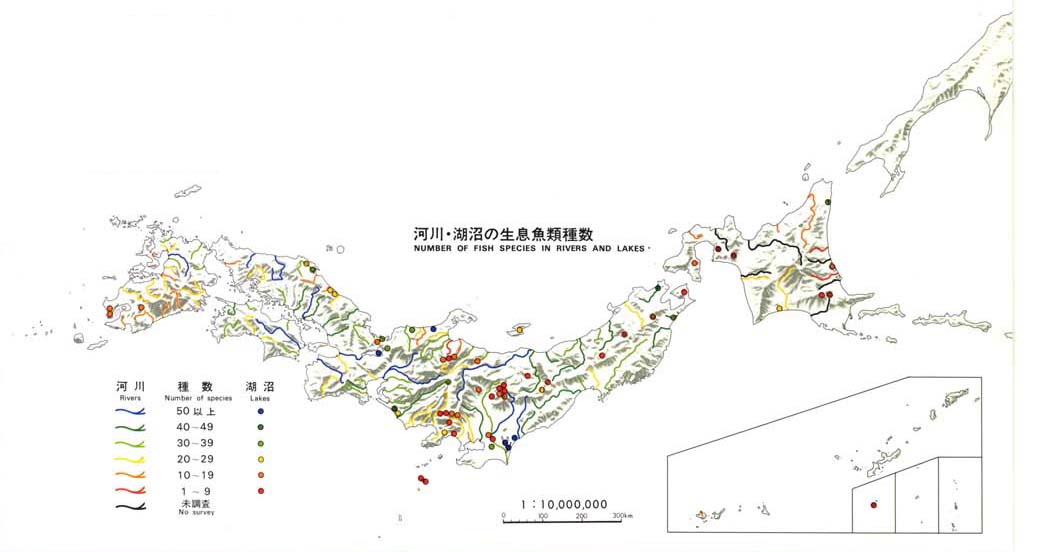
|
34.
|
日本の淡水魚 FRESHWATER FISHES OF JAPAN |
||
|
淡水魚相とその区分 日本の陸水域には200種類近くの魚類が出現する。しかしこれはボラやスズキのように一時的に淡・汽水域に入る海産魚や、ニジマス、ソウギョ、ヒレナマズ、カダヤシ、タイワンドジョウなど約20種の外来種を含めた数であって、いわば本当の淡水魚で、しかも日本に自然分布するものは115種類内外である。 このような日本の淡水魚は、大きく分けるとその成立の起源を異にする3つのグループに分けられる。第1のグループは、元来淡水中で進化し海水中では生存できない純淡水魚(第一次淡水魚)であり、これはコイ目のコイ科とドジョウ科の60数種類とナマズ目の7種のみである。第2のものは、本来淡水生活者であるが海水中にもある程度生存できる第二次淡水魚で、これはメダカ1種のみである。第3は、周縁性淡水魚、すなわち、遡・降河性魚とその陸封型や海産の系統から分化した淡水魚である。イワナ、オヤニラミ、ウナギ、トゲウオ類などの魚類で、さきにあげたグループ以外の淡水魚はすべてこれに含まれる。 淡水魚相の特徴 日本の純淡水魚相はアジア大陸東部のそれと比較して種数が少ない。すなわち、現在大陸部には分布しているが、日本には現生しないコイ科の一群があり、また、日本には原産しないが、大陸部には分布しているキノボリウオ類、タイワンドジョウ類などの純淡水魚がかなりある。しかし、大陸部との類縁性は強く、属の段階ではほとんどが共通しており、共通種のあるものも少なくない。ただし大陸からの分化もかなり進んでいて、亜種の段階では約半数のものが日本固有のものとなっている。コイ目のホンモロコ、ワタカ、ゲンゴロウブナ、ミヤコタナゴ、アユモドキ、ナマズ目のビワコオオナマズ、アカザなどは、日本固有である。純淡水魚は西日本、とくに琵琶湖を中心とした本州中西部で種類が多く、関東、東北、北海道と北に向かうにしたがって種類が減少する。北海道、とくに石狩低地以東では純淡水魚相はきわめて貧弱である。 一方周縁性淡水魚をみると、北日本にはサケ類やトゲウオ類のような北方系のものが数多く出現する。これに対し、ハゼ類などの南方系のものは中部日本以西に多い。周縁性淡水魚の中にも、日本である程度分化した種類がある。 以上のような日本の淡水魚相は、大陸の純淡水魚を部分的に受け入れてある程度分化させ、あいている生活領域に周縁性淡水魚を受容して成立したものと要約できよう。純淡水魚が少なく、種類が西に多く北に少ないという特徴は、過去、西日本は大陸とのつながりが深かったが、東・北日本の陸域はかなり不定安であったという日本列島の地史的条件と、淡水域が狭小で不定安であるという島しょ的な環境条件とに密接に関連している。 近年では、森林伐採、河川改修、ダムや堰提の構築、水質汚染などによって、淡水魚類の生息域は物理・化学・生態的にいちだんと狭められ、荒廃してきているといえよう。とくに分布域の狭い種では、存亡の危機に立たされているものもあり、すでに絶滅してしまったもの(ミナミトミヨ)もある。 (多紀保彦) |
Division of Freshwater Fishes Excluding introduced freshwater species and marine forms which sporadically enter inland waters, the freshwater fish fauna indigenous to Japan consists of about 115 species and subspecies. Of these, more than 60 species/subspecies of the Cypriniformes (carps, minnows and loaches) and seven species of the Siluriformes (catfishes) are primary-division freshwater fishes strictly confined to fresh water; one species of the Cyprinodontiformes (killifishes), the medaka, is the only representative of the comparatively salt-tolerant secondary division; and the remaining, including diadromous fishes and freshwater species derived from marine groups, such as the Japanese forms of freshwater eels, salmons and chars, ayu sweetfish, sticklebacks, perciforms, and sculpins, are freshwater fishes of the peripheral division. Characteristics of Freshwater Fish Fauna The primary freshwater fish fauna of Japan is less abundant in number of species than that of continental East Asia. While the Japanese fauna is closely related to the fauna of continental East Asia, with the majority of the Japanese genera common to the continent, differentiation of mainly subspecific levels has resulted in the occurrence of a number of endemic forms in Japan. In the number of species, the strictly freshwater fish fauna abounds in western Japan, particularly in central and western Honshu with Lake Biwa as a center of abundance. It becomes poorer eastward and northward, and extremely poor in Hokkaido, especially in its northern and eastern parts. In the peripheral freshwater fish fauna, northern elements such as salmonids, sticklebacks, and sculpins are well represented in northern Japan, and southern elements such as gobies occur mostly in western and southern Japan. Some of these peripheral freshwater fishes are endemic to Japan. The freshwater fish fauna of Japan as seen above was probably established through receiving and partly differentiating a part of the continental primary freshwater fish fauna and accomodating peripheral freshwater species in vacant niches. The comparative poverty in strictly freshwater fish groups in Japan especially in the eastern and northern parts reflects the geohistory of the Japanese Archipelago, since the land areas of eastern and northern Japan were unstable until recently, and also reflects the insular environment of Japan with a small area of unstable fresh water. The habitats of freshwater fishes have been increasingly desolated and narrowed due to deforestation, dam construction and other environmental changes in water bodies, water pollution, and other human influences. Some species, particularly those having very small ranges, are in a critical situation or have already become extinct. (Yasuhiko Taki) |
||
|
|